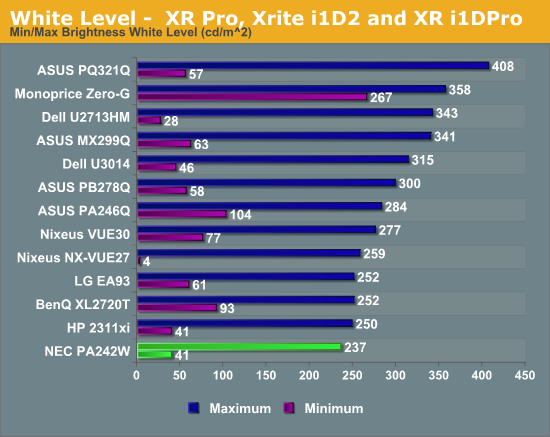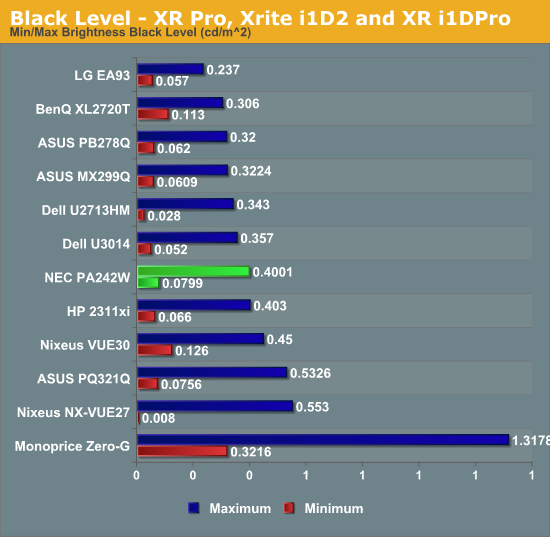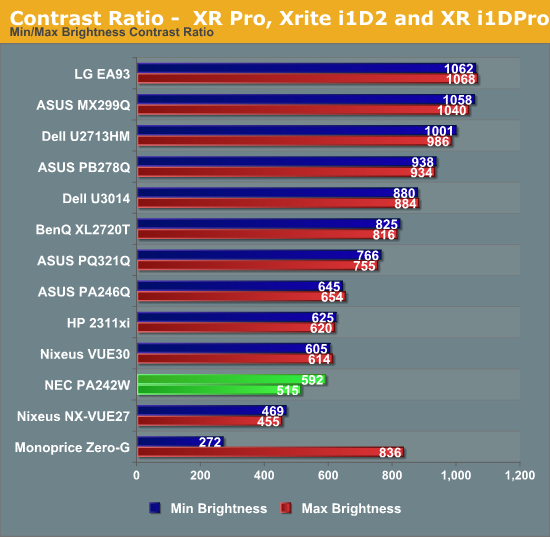NEC PA242W Monitor Review
by Chris Heinonen on September 27, 2013 9:00 AM ESTAs noted on the previous page, NEC limits the upper level of the PA242W backlight to 240 cd/m2. You can go beyond this, but the control turns red to let you know that overall performance is suffering. The construction of the PA242W is designed to make it as uniform and even a display as possible. Pushing the backlight too far will reduce that. No one that is using this monitor in a professional setting would need light output beyond that, so I used that level for the maximum setting here.
If you want to go beyond that, the NEC can produce 287 cd/m^2 at maximum. The minimum setting produces 41.19 cd/m^2, very close to the on screen reading of 40 cd/m^2. The 240 cd/m^2 setting produces 236.7 cd/m^2, also very close. You can adjust this to any level between in 1 cd/m^2 increments. For white level control, the NEC PA242W is unmatched in my experience.

Black level is not quite as good as white level. At the 240 cd/m^2 level we have a black level of 0.4001 cd/m^2 and at the minimum setting we see a level of 0.0799 cd/m^2. That is a very low minimum, but no other monitor has a minimum setting of only 40 cd/m^2 either.

The contrast ratios that result from the above are only fair, 515:1 for the minimum setting and 592:1 for the 240 cd/m^2 level. Curiously the maximum setting produces a contrast ratio of 699:1 indicating that the NEC can do better if you sacrifice uniformity. For movies and TV people typically value contrast ratio above all, but for production work, uniformity might be more important. We will see if this sacrifice winds up being worth it later.











74 Comments
View All Comments
cheinonen - Monday, September 30, 2013 - link
The current version of CalMAN, at least one of the higher end versions, has support for calibrating a set of displays to look identical. It might mean none of them are perfect, but they all look about the same. I've never tested it out, as it's meant for commercial installations, but that might help with this issue if you already have the monitors.1Angelreloaded - Saturday, October 5, 2013 - link
instead of using 3 monitors, have you ever thought about moving to a large format display they make professional based ones for 40inch and higher now at 4k levels with IPS tech, that's a lot more realestate than say 3 1080p s side by side.nathanddrews - Friday, September 27, 2013 - link
I think I already know the answer to this: "too much".How much would it actually add to the cost of a monitor to have it pre-calibrated using this method at the factory? Obviously a trained human would be expensive and time consuming, but what about a series of sensors on the assembly line that tune the display before packaging? Panels that meet the requirements for uniformity and gamut get one price, displays that can't make the cut go off to a different bin. Doesn't seem too ridiculous to me.
Senti - Friday, September 27, 2013 - link
The problem is the transportation after that will likely screw everything in unpredictable way.nathanddrews - Friday, September 27, 2013 - link
How, exactly? I've never heard of shipping or transporting affecting display calibration...foxalopex - Friday, September 27, 2013 - link
Professional calibration software like Spectraview is designed to ask for a recalibration every 2-4 weeks. So yes by the time it gets to you it's not as calibrated as it could be. Keep in mind this is a professional monitor so they're nothing like a normal user. If you're more on a budget, a good $600-700 IPS monitor would probably work for most folks but for folks who insist on the best, you can't go wrong.DanNeely - Friday, September 27, 2013 - link
That drift is due to components aging with; a good factory calibration should still be good when you unbox it and will stay better than what we normally suffer with for a while since the bad one is drifting too.Some tablet vendors have been doing it for at least a year now. I'd be interested in seeing how much the screens on them have drifted if Anandtech used any of the tablets they did color calibration testing a year ago as daily drivers.
bobbozzo - Friday, September 27, 2013 - link
see above:cheinonen - Friday, September 27, 2013
...the out-of-box experience is also very good and it is still more uniform than any other display tested to date. The calibration does not affect the uniformity.
cheinonen - Saturday, September 28, 2013 - link
Just as an FYI, measuring the uniformity to the degree that I do takes close to two hours per display. That's with a fast meter and moving it between locations as quickly as possible but still allowing time for each sample to settle and be accurate. Adding that kind of testing to every display will increase the price a lot. Most companies wouldn't see any return on investment there, since the majority of consumers still don't care enough. Even if you only add $25 to the cost, that's a lot for most people unless you're talking about $1,200 displays.dushyanth - Friday, September 27, 2013 - link
which would you choose: Eizo CS230 or this